2012年高考英语(人教版)要点梳理+重点突破:必修2 Unit 5 Music
- 格式:doc
- 大小:155.00 KB
- 文档页数:60
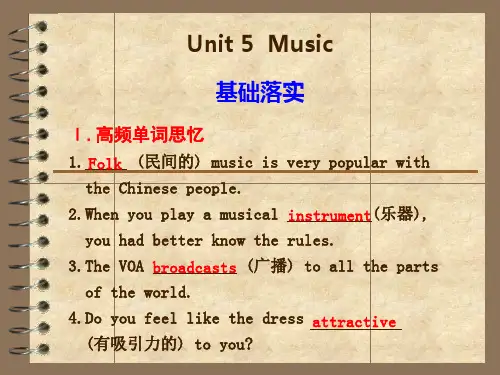
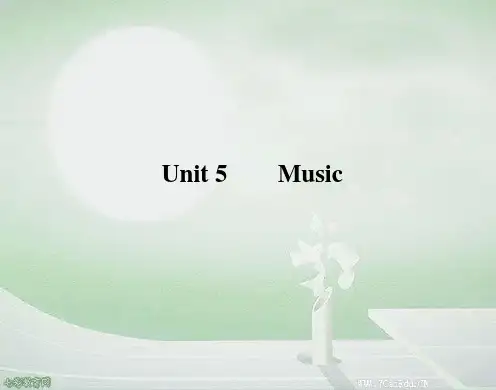
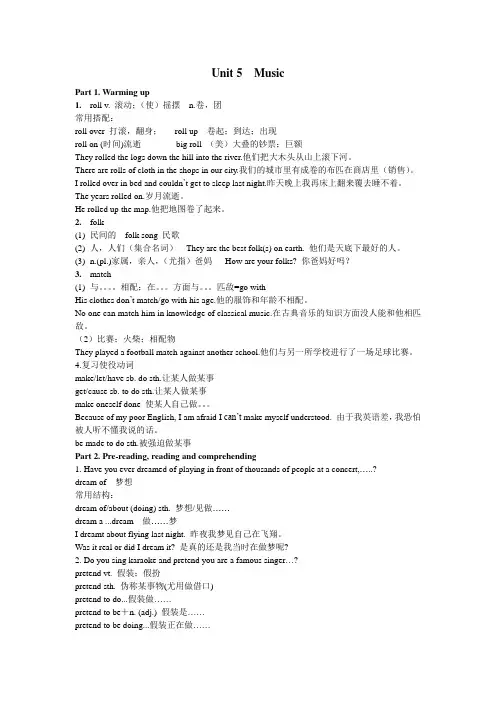
Unit 5 MusicPart 1. Warming up1.roll v. 滚动;(使)摇摆n.卷,团常用搭配:roll over 打滚,翻身;roll up 卷起;到达;出现roll on (时间)流逝big roll (美)大叠的钞票;巨额They rolled the logs down the hill into the river.他们把大木头从山上滚下河。
There are rolls of cloth in the shops in our city.我们的城市里有成卷的布匹在商店里(销售)。
I rolled over in bed and couldn’t get to sleep last night.昨天晚上我再床上翻来覆去睡不着。
The years rolled on.岁月流逝。
He rolled up the map.他把地图卷了起来。
2.folk(1)民间的folk song 民歌(2)人,人们(集合名词)They are the best folk(s) on earth. 他们是天底下最好的人。
(3)n.(pl.)家属,亲人,(尤指)爸妈How are your folks? 你爸妈好吗?3.match(1)与。
相配;在。
方面与。
匹敌=go withHis clothes don’t match/go with his age.他的服饰和年龄不相配。
No one can match him in knowledge of classical music.在古典音乐的知识方面没人能和他相匹敌。
(2)比赛;火柴;相配物They played a football match against another school.他们与另一所学校进行了一场足球比赛。
4.复习使役动词make/let/have sb. do sth.让某人做某事get/cause sb. to do sth.让某人做某事make oneself done 使某人自己做。
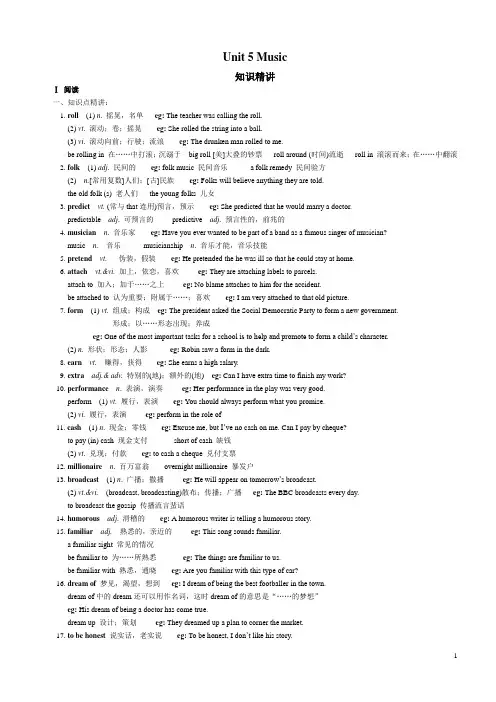
Unit 5 Music知识精讲Ⅰ阅读一、知识点精讲:1. roll (1) n. 摇晃,名单eg: The teacher was calling the roll.(2) vt. 滚动;卷;摇晃eg: She rolled the string into a ball.(3) vi. 滚动向前;行驶;流浪eg: The drunken man rolled to me.be rolling in 在……中打滚;沉溺于big roll [美]大叠的钞票roll around (时间)流逝roll in 滚滚而来;在……中翻滚2. folk (1) adj. 民间的eg: folk music 民间音乐 a folk remedy 民间验方(2) n.[常用复数]人们;[古]民族eg: Folks will believe anything they are told.the old folk (s) 老人们the young folks 儿女3. predict vt. (常与that连用)预言,预示eg: She predicted that he would marry a doctor.predictable adj. 可预言的predictive adj. 预言性的,前兆的4. musician n. 音乐家eg: Have you ever wanted to be part of a band as a famous singer of musician?music n. 音乐musicianship n. 音乐才能,音乐技能5. pretend vt.伪装,假装eg: He pretended the he was ill so that he could stay at home.6. attach vt.&vi.加上,依恋,喜欢eg: They are attaching labels to parcels.attach to 加入;加于……之上eg: No blame attaches to him for the accident.be attached to 认为重要;附属于……;喜欢eg: I am very attached to that old picture.7. form (1) vt. 组成;构成eg: The president asked the Social Democratic Party to form a new government.形成;以……形态出现;养成eg: One of the most important tasks for a school is to help and promote to form a child’s character.(2) n.形状;形态;人影eg: Robin saw a form in the dark.8. earn vt.赚得,获得eg: She earns a high salary.9. extra adj.& adv.特别的(地);额外的(地) eg: Can I have extra time to finish my work?10. performance n. 表演,演奏eg: Her performance in the play was very good.perform (1) vt. 履行,表演eg: You should always perform what you promise.(2) vi.履行,表演eg: perform in the role of11. cash (1) n. 现金;零钱eg: Excuse me, but I’ve no cash on me. Can I pay by cheque?to pay (in) cash 现金支付short of cash 缺钱(2) vt. 兑现;付款eg: to cash a cheque 兑付支票12. millionaire n. 百万富翁overnight millionaire 暴发户13. broadcast(1) n. 广播;撒播eg: He will appear on tomorrow’s broadcast.(2) vt.&vi. (broadcast, broadcasting)散布;传播;广播eg: The BBC broadcasts every day.to broadcast the gossip 传播流言蜚语14. humorous adj. 滑稽的eg: A humorous writer is telling a humorous story.15. familiar adj.熟悉的,亲近的eg: This song sounds familiar.a familiar sight 常见的情况be familiar to 为……所熟悉eg: The things are familiar to us.be familiar with 熟悉,通晓eg: Are you familiar with this type of car?16. dream of 梦见,渴望,想到eg: I dream of being the best footballer in the town.dream of中的dream还可以用作名词,这时dream of的意思是“……的梦想”eg: His dream of being a doctor has come true.dream up 设计;策划eg: They dreamed up a plan to corner the market.17. to be honest 说实话,老实说eg: To be honest, I don’t like his story.to be frank 坦率地说to be sure 自然,固然18. play joke on开某人玩笑,戏弄某人eg: It’s not polite to play a joke on a disabled person.19. rely on 依赖,信赖eg: You should rely on your own efforts.rely与depend的区别:rely指“在过去经验的基础上,依赖某人或某事物,希望从中得到支持或帮助”eg: He can be relied on to keep the secret.depend指“出于信赖而依靠他人或他物,以取得其支持或帮助,这种信赖可能有过去的经验为根据,也可能没有”eg: He can depend on his wife for sympathy.20. or so 左右,上下an hour or so 一小时左右 a pound so 一磅左右21. break up分裂;结束;放假;逗乐eg: Their marriage broke up.break in 闯入;打断;插嘴break into 闯入;打断;插嘴break out 逃脱;突然发生break through 突破break down 毁掉,分解(侧重化学分解)22. Have you ever wanted to be part of a band as a famous singer or musician?ever (1) 曾经eg: It is one of the ugliest faces I have ever seen.(2) (加强语气)究竟eg: How ever do you find the time to learn cooking?(3) (与so,such连用)十分,非常eg: He is ever so diligent.(4) 总是;始终eg: I have lived here ever since I was a child.23. However, there was one band that started in a different way.however(1) conj.然而,可是eg: Certainly he apologized. However, I won’t forgive him.however与but的区别:二者意义相同;但however是较正式的说法。
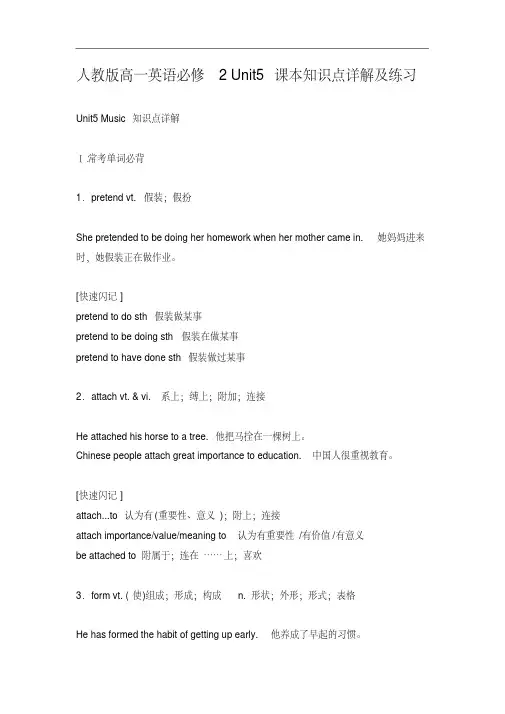
人教版高一英语必修 2 Unit5 课本知识点详解及练习Unit5 Music知识点详解Ⅰ.常考单词必背1.pretend vt. 假装;假扮She pretended to be doing her homework when her mother came in. 她妈妈进来时,她假装正在做作业。
[快速闪记]pretend to do sth 假装做某事pretend to be doing sth 假装在做某事pretend to have done sth 假装做过某事2.attach vt. & vi. 系上;缚上;附加;连接He attached his horse to a tree. 他把马拴在一棵树上。
Chinese people attach great importance to education. 中国人很重视教育。
[快速闪记]attach...to 认为有(重要性、意义);附上;连接attach importance/value/meaning to 认为有重要性/有价值/有意义be attached to 附属于;连在……上;喜欢3.form vt. (使)组成;形成;构成 n. 形状;外形;形式;表格He has formed the habit of getting up early. 他养成了早起的习惯。
[快速闪记]form the habit of... 养成……的习惯in the form of 呈……的形状;以……的形式存在be in good/great form 情绪良好;兴高采烈4.earn vt. 赚;挣得;获得The old man earned his living by selling newspapers. 那位老人通过卖报来谋生。
[快速闪记](1)earn one's respect/reputation 赢得某人尊敬/名誉earn one's living=make a living 谋生(2)earnings n. 所得;收入,工资5. perform vt. & vi. 表演;履行;执行He performed very well in the speech competition. 他在演讲比赛中表现得很好。
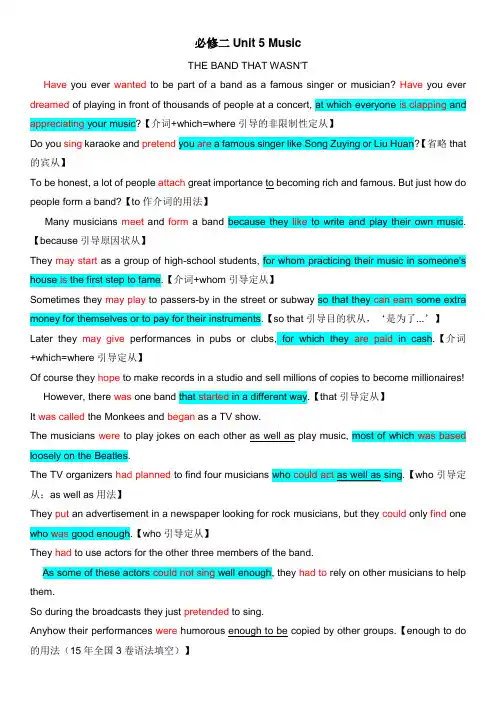
必修二Unit 5 MusicTHE BAND THAT WASN'THave you ever wanted to be part of a band as a famous singer or musician? Have you ever dreamed of playing in front of thousands of people at a concert, at which everyone is clapping and appreciating your music?【介词+which=where引导的非限制性定从】Do you sing karaoke and pretend you are a famous singer like Song Zuying or Liu Huan?【省略that 的宾从】To be honest, a lot of people attach great importance to becoming rich and famous. But just how do people form a band?【to作介词的用法】Many musicians meet and form a band because they like to write and play their own music.【because引导原因状从】They may start as a group of high-school students, for whom practicing their music in someone's house is the first step to fame.【介词+whom引导定从】Sometimes they may play to passers-by in the street or subway so that they can earn some extra money for themselves or to pay for their instruments.【so that引导目的状从,‘是为了...’】Later they may give performances in pubs or clubs, for which they are paid in cash.【介词+which=where引导定从】Of course they hope to make records in a studio and sell millions of copies to become millionaires!However, there was one band that started in a different way.【that引导定从】It was called the Monkees and began as a TV show.The musicians were to play jokes on each other as well as play music, most of which was based loosely on the Beatles.The TV organizers had planned【who引导定从;as well as用法】They put an advertisement in a newspaper looking for rock musicians, but they could only find one who was good enough.【who引导定从】They had to use actors for the other three members of the band.As some of these actors could not sing well enough, they had to rely on other musicians to help them.So during the broadcasts they just pretended to sing.Anyhow their performances were humorous enough to be copied by other groups.【enough to do 的用法(15年全国3卷语法填空)】They were so popular that their fans formed clubs in order to get more familiar with them.【so...that...引导结果状从,‘太...以致于...’(19年全国3卷语法填空)】Each week on TV, the Monkees would play and sing【done作后置定语】However, after a year or so in which they became more serious about their work, the Monkees started to play and sing their own songs like a real band.【in which=when引导定从】Then they produced their own records and started touring and playing their own music.In the USA they became even more popular than the Beatles and sold even more records.The band broke up about 1970, but happily they reunited in the mid-1980s. They produced a new record in 1996, with which they celebrated their former time as a real band.【with+which引导定从】并非乐队的乐队你曾经想过要成为一个乐队里有名的歌手或音乐家吗?你是否曾梦想过在音乐会上面对成千上万的观众演唱,观众欣赏你的歌唱为你鼓掌吗?你唱卡拉OK时是否假装自己就是像宋祖英或刘欢一样著名的歌星吗?说实在的,很多人把名和利看得很重。
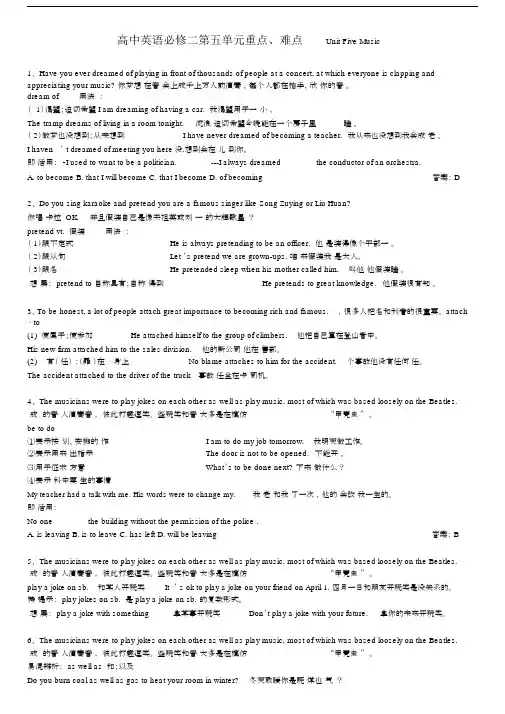
高中英语必修二第五单元重点、难点Unit Five Music1、 Have you ever dreamed of playing in front of thousands of people at a concert, at which everyone is clapping and appreciating your music? 你梦想 在音 会上成千上万人前演奏 ,每个人都在拍手,欣 你的音 。
dream of 用法 :( 1)渴望;迫切希望I am dreaming of having a car. 我渴望用于一 小 。
The tramp dreams of living in a room tonight. 流浪 迫切希望今晚能在一个房子里 ( 2)做梦也没想到;从未想到 I have never dreamed of becoming a teacher.睡 。
我从来也没想到我会成 老 。
I haven ’ t dreamed of meeting you here 没.想到会在 儿 到你。
即 活用: –I used to want to be a politician.---I always dreamed _______ the conductor of an orchestra.A. to becomeB. that I will becomeC. that I becomeD. of becoming答案: D2、 Do you sing karaoke and pretend you are a famous singer like Song Zuying or Liu Huan?你唱 卡拉 OK 并且假装自己是像宋祖英或刘 一 的大牌歌星 ?pretend vt. 假装 用法 :( 1)跟不定式 He is always pretending to be an officer. 他 是装得像个干部一 。
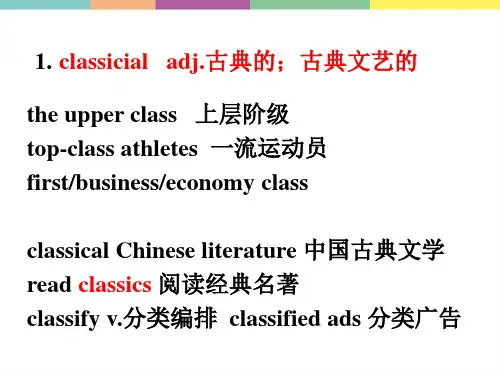
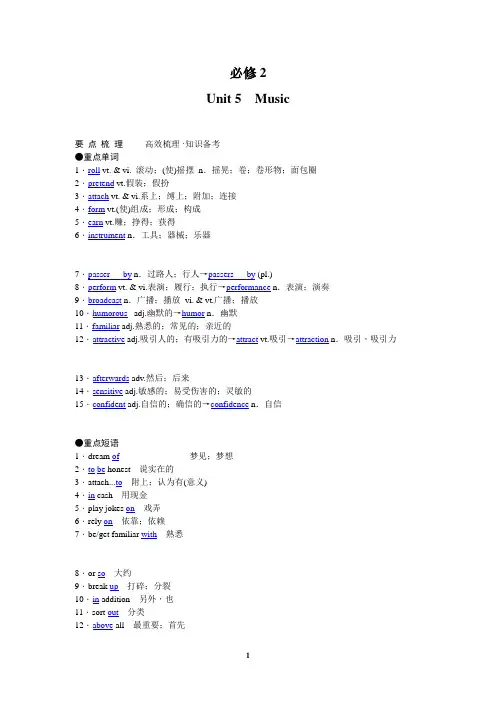
必修2Unit 5Music要点梳理高效梳理·知识备考●重点单词1.roll vt. & vi. 滚动;(使)摇摆n.摇晃;卷;卷形物;面包圈2.pretend vt.假装;假扮3.attach vt. & vi.系上;缚上;附加;连接4.form vt.(使)组成;形成;构成5.earn vt.赚;挣得;获得6.instrument n.工具;器械;乐器7.passer by n.过路人;行人→passers by (pl.)8.perform vt. & vi.表演;履行;执行→performance n.表演;演奏9.broadcast n.广播;播放vi. & vt.广播;播放10.humorous_ adj.幽默的→humor n.幽默11.familiar adj.熟悉的;常见的;亲近的12.attractive adj.吸引人的;有吸引力的→attract vt.吸引→attraction n.吸引,吸引力13.afterwards adv.然后;后来14.sensitive adj.敏感的;易受伤害的;灵敏的15.confident adj.自信的;确信的→confidence n.自信●重点短语1.dream of梦见;梦想2.to be honest 说实在的3.attach...to附上;认为有(意义)4.in cash 用现金5.play jokes on戏弄6.rely on依靠;依赖7.be/get familiar with熟悉8.or so大约9.break up打碎;分裂10.in addition 另外,也11.sort out分类12.above all 最重要;首先13.be based on以……为基础14.be serious about对……认真15.by cheque 用支票16.stick to坚持●重点句型1.Freddy and his band could not go out anywhere without being followed弗雷迪和他的乐队走到哪里都会有人跟随。

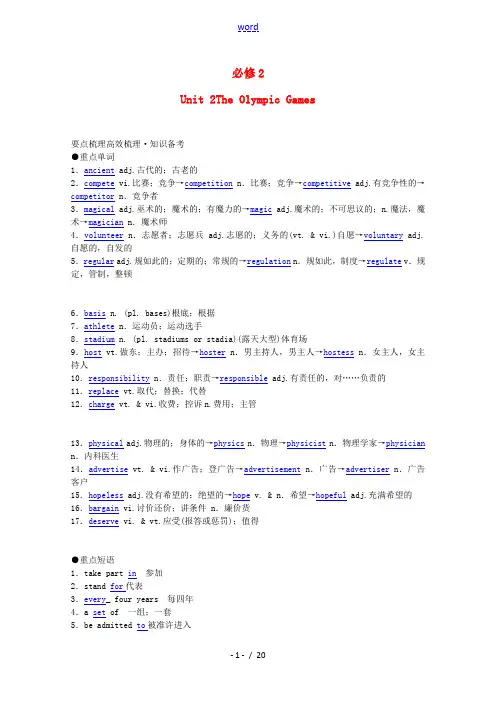
必修2Unit 2The Olympic Games要点梳理高效梳理·知识备考●重点单词1.ancient adj.古代的;古老的2.compete vi.比赛;竞争→competition n.比赛;竞争→competitive adj.有竞争性的→competitor n.竞争者3.magical adj.巫术的;魔术的;有魔力的→magic adj.魔术的;不可思议的;n.魔法,魔术→magician n.魔术师4.volunteer n.志愿者;志愿兵adj.志愿的;义务的(vt. & vi.)自愿→voluntary adj.自愿的,自发的5.regular adj.规如此的;定期的;常规的→regulation n.规如此,制度→regulate v.规定,管制,整顿6.basis n. (pl. bases)根底;根据7.athlete n.运动员;运动选手8.stadium n. (pl. stadiums or stadia)(露天大型)体育场9.host vt.做东;主办;招待→hoster n.男主持人,男主人→hostess n.女主人,女主持人10.responsibility n.责任;职责→responsible adj.有责任的,对……负责的11.replace vt.取代;替换;代替12.charge vt. & vi.收费;控诉n.费用;主管13.physical adj.物理的;身体的→physics n.物理→physicist n.物理学家→physician n.内科医生14.advertise vt. & vi.作广告;登广告→advertisement n.广告→advertiser n.广告客户15.hopeless adj.没有希望的;绝望的→hope v. & n.希望→hopeful adj.充满希望的16.bargain vi.讨价还价;讲条件 n.廉价货17.deserve vi. & vt.应受(报答或惩罚);值得●重点短语1.take part in参加2.stand for代表3.every_ four years 每四年4.a set of 一组;一套5.be admitted to被准许进入6.play an important role in 在……中起重要作用7.as well 也,又,还8.in charge 主管;看管9.one after another 陆续地;一个接一个地10.pick up拾起●重点句型1.I lived in what you call“Ancient Greece〞 and I usedto write about the Olympic Games a long time ago. 我生活在你们所说的“古希腊〞,我曾经写过很久以前奥林匹克运动会的情况。
2012年高考英语知识点必修二Module 5单元总复习教案2012届高考英语一轮单元总复习讲义精品荟萃外研版必修二dule5 知识详解①ngratulatin n.祝贺;祝贺词henanglanded,Preiereniabatelephnedthentrlentretfferhisngratulatins 当杨利伟着陆的时候,温家宝总理打电话到控制中心表示祝贺。
【归纳总结】ngratulatins!祝贺!恭喜!ffer/sendne’sngratulatinstsbnsth为某事向某人祝贺……ngratulatev祝贺ngratulatesbnsth向某人祝贺……ngratulateneselfn暗自庆幸……【例句探源】①efferedrangurngratulatinsnhissuessinbusiness我们祝贺王先生生意兴隆。
②uareadittedtBeiingUniversitngratulatins!你被北京大学录取了。
恭喜!③engratulatedurnitrnbeingeletedhairanftheStudents’Unin我们祝贺我们的班长被选为学生会主席。
ngratulate,elebratengratulate指对某人取得的成就或喜庆之事表示“庆贺,祝贺”,其宾语是“人”,常与介词n搭配。
elebrate指对某一节日、生日、胜利和成功等的“庆祝”,其宾语是物。
①engratulated_hinhavingpassedtheexainatin②entnlngratulatedhinhavingpassedtheinterviebutalsheldapartte lebrateit【易混辨析】.—hnandIillelebrateurfrtietheddinganniversarnextnth—h,________!A.heerup B.elldne.gaheadD.ngratulatins解析:选D。
要1 2 3 4 567 8 9 10 11 12 n 13 14151 2 3 4 5 6 7 891.3.主题:我国中小学生近视(short-sightedness)问题基本信息:(1)发生率:略高于50%(2)人数:世界第一专家解读:(1)原因:很复杂(2)治疗:没有哪一种药物能治愈近视(3)建议:不要过度用眼;多参加户外活动(4)特别提示:如何握笔也和近视有关__________________________________________________________________________________[范文]Last weekend, I had an interview with Professor Wang, an eye-doctor,concerning the issue of short-sightedness of school children in China. According to Professor Wang, slightly more than half of the school children in our country are short-sighted, ranking the first in the world. He also pointed out that the causes of short-sightedness are so complicated that no medicine can cure short-sightedness. He suggested that school children avoid overuse of their eyes and do more outdoor activities. He particularly reminded us that how to hold a pen is also related to short-sightedness.考点探究互动探究·能力备考Ⅰ.词汇短语过关1.pretend vt. 假装;假扮pretend sth. 伪称某事物(尤用做借口)pretend to do...假装做……pretend to be+n. (adj.) 假装是……pretend to be doing...假装正在做……pretend to have done... 假装已做……pretend that-clause 假装……[即学即练1](1)He _______________________ yesterday.昨天他假装头疼。
(2)We mustn't _______________________ what we don't know.我们不应不懂装懂。
(3)He _______________________________ when he met a bear.当他遇到熊时就装死。
pretended a headachepretend to knowpretended to be dead2.attach vt. 系;贴;附加;认为有(重要性等)attached adj. 依恋的,留恋的attachment n. [C]附件[C,U]依恋;眷恋;深爱attach sth. to sth. 把某物系到某物上attach yourself to sb./sth. 参加,和……在一起attach to sb./sth.与……有联系,与……有关联be attached to sb./sth. 依恋,留恋[即学即练2](1)She __________ a cheque ____ the order form.她在订货单上附了一张支票。
(2)Don't worry—there are no strings _____________.不用担心——没有附加的条件。
(3)She ____________________________ the regular exercise. 她对常规训练极为重视。
(4)No blame __________________ him for the accident.这次事故的责任与他无关。
(5)I am deeply _____________________ this novel.我非常喜欢这部小说。
attachedtoattachedattaches great importance toattaches toattached to3.form vt. & vi. 形成;组织;养成;培养n. 形式;表格;形状,外形;状况;精神form(=set up) a club 成立俱乐部form a good habit 养成好习惯form the habit of=fall/get into the habit of养成……的习惯form an organization 成立一个组织fill in the form 填表格in the form of 以……的形式in/out of form 状况良好/不佳[即学即练3](1)The footballer's been ________________.这个足球运动员的状态不好。
(2)He is ____________ the application ______.他正在填申请表。
(3)His research ______ the basis of the new book.他的研究成果是这本新书的基础。
(4)The teacher ______ the students ______ a line.老师让学生排成一行。
out of formfilling informformedformedinto4.earn vt. 赚得;挣得;获得earn one's living=make a living 谋生earn one's own living 自食其力earn money=make money 挣钱[即学即练4](1)His courage ______________________of his classmates.他的勇敢博得了同学们的赞扬。
(2)Do you know how much he ___________ a month?你知道他一个月赚多少钱吗?(3)He _________________________ by teaching at a language school.他在语言学校教书以维持生计。
earned him the admirationearnsearns his living5.perform vt.&vi 表演;履行;执行performance n. 履行,执行;表演performer n. 执行者;表演者perform one's promise 守信;履行诺言perform duty 尽职perform a part in... 在……中扮演角色perform an experiment 做实验give/put on a performance 演出[即学即练5](1)The students will ___________________ next Friday.这些学生下星期五将演出一场歌剧。
(2)The police _________________________ in our society.警察在我们的社会中起着极其重要的作用。
(3)You shall _________________________ the way they do.你们要按照他们的方法去做实验。
(4)Our team _______________ in the match.我们队在比赛中表现很出色。
perform an operaperform a vital roleperform the experimentperformed well6.familiar adj. 熟悉的;常见的;通晓的;亲密的(1)be familiar with 对……熟悉。
其主语通常是指“人”的名词;with后的宾语是主语所通晓的事物。
(2)be familiar to 为……所熟悉。
其主语通常是人们所通晓的人或事物,to后的宾语常是指“人”的名词。
(3)sb. be familiar with sb. 某人与某人亲密无间[即学即练6](1)Yao Ming is ____________________ to us.姚明是我们大家所熟悉的明星。
(2)Are you ______________ the computer software they use? 你熟悉他们使用的计算机软件吗?(3)This nursery rhyme is very ______________ me.我对这首童谣很熟悉。
a familiar starfamiliar withfamiliar to7.to be honest 说实在的;实话说honestly speaking 老实说to tell the truth 说实话,老实说to be honest with you 跟你说实话be honest with sb. about sth. 关于某事对……坦诚be honest in doing sth. 在做某事方面坦诚It is honest of sb. to do sth. ……在干……方面诚实。
[即学即练7](1)_________________________________,I don’t agree with you.对你说实话,我不同意你的看法。
(2)I think she is _____________ what she is telling me.我认为她很诚实地告诉我一切。
(3)It is ________________________ to tell the truth.你讲实话是诚实的。
(4)_________________,I hate the student wearing long hair.说实在的,我讨厌那位留着长发的学生。
To be honest with youhonest inhonest of youHonestly speaking8.play jokes/a joke on 戏弄……;和……开玩笑have a joke with sb. 和某人开玩笑make a joke/jokes about sb./sth. 关于某人/某事说笑话play tricks on sb.=make fun of sb. 和……开玩笑;捉弄某人make a fool of 愚弄laugh at 嘲笑[即学即练8](1)It's not proper to ____________________ others in public.在公众场所捉弄别人是不恰当的。